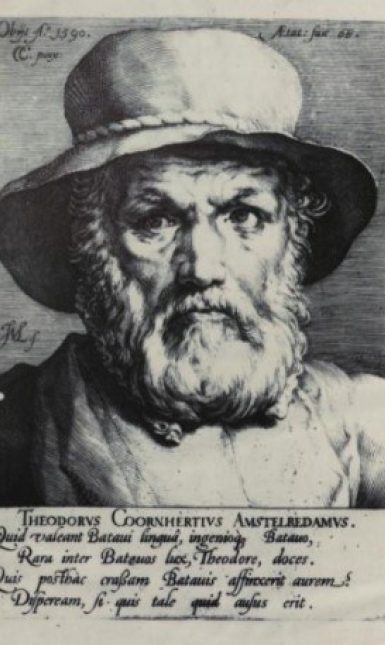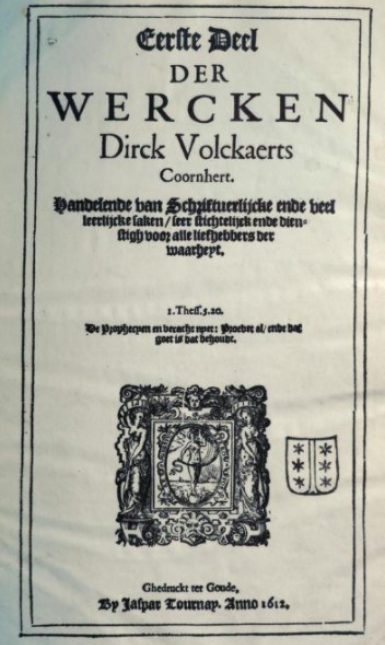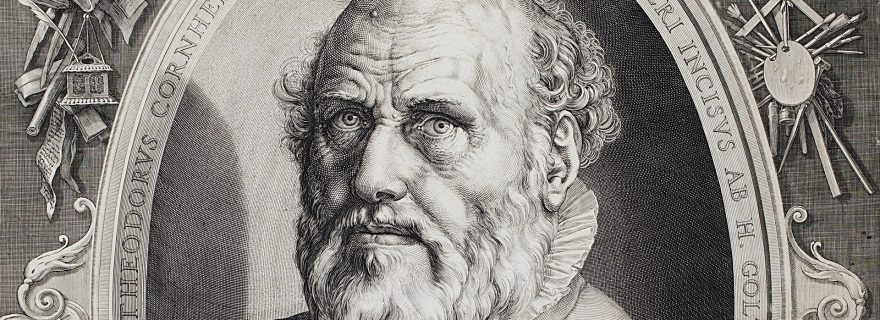The forgotten Reformer. The life and printed works of Dirck Volckertszoon Coornhert
On October the 29th in the year 1590, one of the greatest minds of the Dutch Reformation, Dirck Volckertszoon Coornhert (1522-1590), passed away in Gouda. Coornhert is not as well-known as some of his contemporaries, but nonetheless he was a very interesting and influential thinker.
Coornhert came from a humble family; his father was a cloth merchant in Amsterdam. Nonetheless, Dirck was able to travel through Europe in his youth. Coornhert was truly a man of many talents; he was a copper engraver, a musician and in his youth he dabbled in fencing. Later, in his thirties, he began to study the Latin language to read the Church Fathers in the original language. He wrote translations of Seneca, Boethius, Paulus Jovius, Cicero and probably many more. His most influential works are more theological in nature but he also wrote plays, dialogues, a songbook and short essays on the prison system, education, war and on the subject of sleep(!).


If one would describe Coornhert in one word, it would probably be ‘tolerant’. He fled the country many times to go into exile. Once, after he was imprisoned by the Spanish for his role as an advisor to the Prince of Orange (during this imprisonment he wrote about the prison system as a form of punishment and the reasons for criminality).1 Another time, after speaking out against the violence that was committed by one of the leaders of the Watergeuzen, William II de La Marck, he fled to the city of Emden, one of the strongholds of the Reformation and a refuge for many Dutch Reformers.2
In his later years, he moved to Gouda, where he worked with the printer Jasper Tournay. Tournay published many of Coornhert’s works. In my research, I focussed on the published, printed oeuvre of Coornhert so the following data are in regard to these printed works. About 79 titles (not including reprints) have been indexed during my research. Of these 79, 28 were published by Tournay between 1584 and 1626. Coornhert’s first printed work which was published was not from Tournay’s press but was printed in Haarlem in 1561 when Tournay was still an infant. This was the translation of the first twelve books of the Odyssey. The last time Coornhert’s work was printed was in 1630 in Amsterdam. This was a collection of some of his works, partly re-published and partly unknown works (Dieryck Volckertsz. Coornherts Wercken in three parts, printed by Jacques Aertsz. Colom, Amsterdam 1630). This was not the first time somebody tried to bundle the works. Tournay had already tried it in 1612. He published the Eerste Deel Der Wercken Dirck Volckaerts Coornhert. The name would suggest that he was planning to publish more parts but as far as we know, he never did. Tournay was probably the one who received Coornhert’s unpublished work after the latter’s death because he was his favourite printer and because they lived in the same city. These works probably moved to Amsterdam some years later. The evidence for this is that the Wercken of 1630 follow the structure of the 1612 version and both contain works that had not been published before.


The reason why Coornhert fell into obscurity is not exactly known. One reason may be that he wrote almost exclusively in the vernacular, unlike Erasmus, Lipsius and De Groot. He did not take part in this international, learned market. Another reason might be that he was very tolerant towards Catholics and critical of violence against dissenters. Much more work is to be done to really appreciate the legacy of this man. There has been research on parts of his work, his plays have been analysed by Fleurkens and his dialogues are used by linguists such as Warnar. A biography has been published by Bonger to illustrate the life of this great humanist. A proposal for further research might be scholarly editions of Coornhert’s work, retranslations and research on the influence of his works. I hope that somewhere in the future, this man gets the recognition that he deserves and that he may be held in the same awe as Erasmus, Lipsius and De Groot.


Author: Frank Happel is a student in the Master's programme Europe, 1000-1800 at Leiden University. His interests are focused around book-culture in the Middle Ages: historiography, manuscripts and printed books, the spread of knowledge and the history of education
Further reading:
1 C. de Bie, Het Gulden Cabinet van de Edel Vry Schilderconst (Antwerp 1661) 454.
2 See the essay Boeventucht ofte Middelen tot mindering der schadelyke ledighghangers (printed by Herman Jansz. Muller, Amsterdam 1587) and the article by the Royal Library.
3 See Andrew Pettegree’s works on the topic of Emden.


